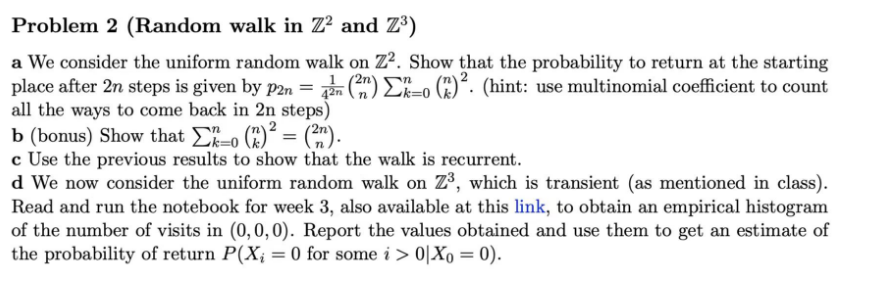the ways to come back in 2n steps) (bonus) Show that -o (2)² = (²n). Use the previous results to show that the walk is recurren We now consider the uniform random walk on Z³, whic ad and run the notebook for week 3, also available at this the number of visits in (0,0,0). Report the values obtain e probability of return P(X; = 0 for some i >0|Xo = 0).
the ways to come back in 2n steps) (bonus) Show that -o (2)² = (²n). Use the previous results to show that the walk is recurren We now consider the uniform random walk on Z³, whic ad and run the notebook for week 3, also available at this the number of visits in (0,0,0). Report the values obtain e probability of return P(X; = 0 for some i >0|Xo = 0).
Linear Algebra: A Modern Introduction
4th Edition
ISBN:9781285463247
Author:David Poole
Publisher:David Poole
Chapter2: Systems Of Linear Equations
Section2.4: Applications
Problem 2EQ: 2. Suppose that in Example 2.27, 400 units of food A, 500 units of B, and 600 units of C are placed...
Related questions
Question

Transcribed Image Text:Problem 2 (Random walk in Z² and Z³)
a We consider the uniform random walk on Z². Show that the probability to return at the starting
place after 2n steps is given by p2n = 42 (2) Σko (2)². (hint: use multinomial coefficient to count
all the ways to come back in 2n steps)
b (bonus) Show that Σo (2)² = (²n).
c Use the previous results to show that the walk is recurrent.
d We now consider the uniform random walk on Z³, which is transient (as mentioned in class).
Read and run the notebook for week 3, also available at this link, to obtain an empirical histogram
of the number of visits in (0, 0, 0). Report the values obtained and use them to get an estimate of
the probability of return P(X; = 0 for some i > 0|Xo = 0).
Expert Solution
This question has been solved!
Explore an expertly crafted, step-by-step solution for a thorough understanding of key concepts.
Step by step
Solved in 4 steps with 2 images

Recommended textbooks for you

Linear Algebra: A Modern Introduction
Algebra
ISBN:
9781285463247
Author:
David Poole
Publisher:
Cengage Learning

Trigonometry (MindTap Course List)
Trigonometry
ISBN:
9781337278461
Author:
Ron Larson
Publisher:
Cengage Learning

Linear Algebra: A Modern Introduction
Algebra
ISBN:
9781285463247
Author:
David Poole
Publisher:
Cengage Learning

Trigonometry (MindTap Course List)
Trigonometry
ISBN:
9781337278461
Author:
Ron Larson
Publisher:
Cengage Learning